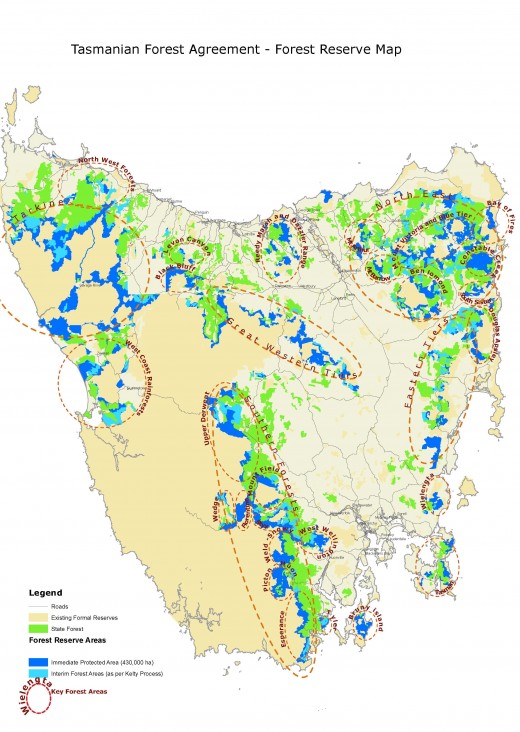Posts Tagged ‘Bill Kelty’
Sunday, January 22nd, 2012
Tags: Bill Kelty, Blueprint for Tasmania's Forest, Conservation Agreement, Contractors Voluntary Exit Grants, ENGO, ENGO Report of Logging breaching IGA, Environmental NonGovernment Organisation, FIAT Submission to Legislative Council, Forest Reserve Map, Forestry Tasmania, Giddings Labor Government, Gillard Labor Government, Heads of Agreement, Independent Verification Group Terms of Reference, interim reserves, National Partnership Agreement, Protecting Private Forests, Tasmanian Forest Contractors Exit Assistance Program, Tasmanian Forests Agreement, Tasmanian Forests Agreement Independent Verification Group, Tasmanian Forests IGA, Tasmanian Forests Intergovernmental Agreement (IGA), Tasmanian Forests Interim Report, Tasmanian Forests Statement of Principles, Tasmanian Regional Forest Agreement, Timber Workers for Forests
Posted in Tasmania (AU), Threats from Deforestation, Threats to Wild Tasmania | No Comments »
Add this post to Del.icio.us - Digg
Sunday, January 15th, 2012
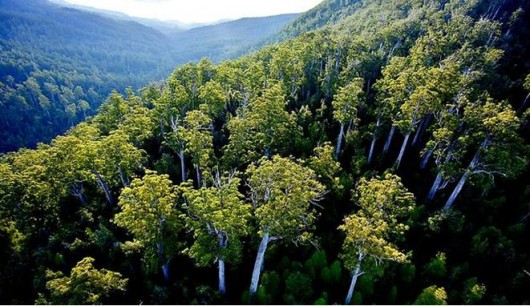 Tasmania’s magnificent ‘Weld Forest’
~ one of Tasmania’s rare ancient forests constantly threatened
by Tasmanian Government recidivist logger ‘Forestry Tasmania’ Tasmania’s magnificent ‘Weld Forest’
~ one of Tasmania’s rare ancient forests constantly threatened
by Tasmanian Government recidivist logger ‘Forestry Tasmania’
.
Australia’s Gillard Labor Government yesterday (20120114) announced an ‘interim legal protection for 428,000 ha’ ahead of tomorrow’s scheduled return of recidivist logging.
This appears good news which obviously the Gillard media release intends. But the process is duplicitous and sly.
Tasmania’s 2011 Forests Agreement is a community agreement about public forest protection involving taxpayer funded Forestry Tasmania so what moral right does the Labor Party have to deny the process being public – i.e. transparent and open? Why is the forest map not publicly online showing the updates of the discussions? Which 1950ha get the chainsaw and why?
This is the only available map. [Read Tasmanian Forest Protection Map 2011]
Professor Jonathan West, Chair of the Independent Verification Group has a lot to answer for. Why has he not voiced outrage publicly of Forestry Tasmania’s illegal logging of the 430.000 hectares of native forests protected in Interim Reserves under the Agreement?
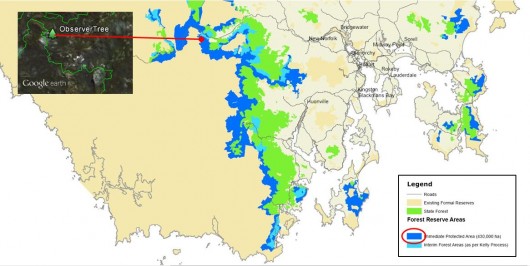
Relative position of the local Tasmanian community protest tree sit The Observer Tree
For ongoing updates visit The ObserverTree.org
.
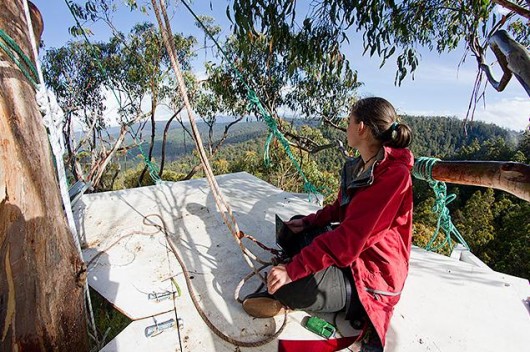 Tasmania’s Forest Defender – Miranda Gibson
stationed in a eco-Tree Sit 60 metres above the Styx Valley Forest floor
Visit: The ObserverTree.org
…waiting for Australia’s Prime Minister Julia Gillard to honour her personal promise to Tasmanians to protect Tasmanian old growth forests for perpetuity.
. Tasmania’s Forest Defender – Miranda Gibson
stationed in a eco-Tree Sit 60 metres above the Styx Valley Forest floor
Visit: The ObserverTree.org
…waiting for Australia’s Prime Minister Julia Gillard to honour her personal promise to Tasmanians to protect Tasmanian old growth forests for perpetuity.
.
572,000 hectares of Tasmania’s remaining old growth
…’as agreed‘ Julia!
.
‘Tassie forests deal like a Gunn to the head’
[Source: ‘Tassie forests deal like a Gunn to the head’, by political journalist Bruce Montgomery in Hobart, ^http://www.crikey.com.au/2011/09/06/tasmanian-forrests-deal-gillard-and-giddings/]above the Styx
.
‘The $276 million agreement that Prime Minister Julia Gillard and Tasmanian Premier Lara Giddings flaunted only a month ago as the ultimate peace deal to end the 40-year war in Tasmania’s forests is dead in the water. It comes as no surprise to those who have sought to interpret the poorly drafted provisions of the intergovernmental agreement (IGA) signed by Gillard and Giddings and those of the agreement that preceded it, the so-called Statement of Principles.
The Statement of Principles was the product of those purporting to represent the Tasmanian forest industry and the conservation movement to achieve a peace, most recently under the guidance of former ACTU secretary Bill Kelty.
Both documents appear to have been the work of plant operators rather than draftspeople. Grammar and proofing blunders aside, the giant flaw in both agreements has been the right of conservation groups to identify and nominate another half a million hectares of Crown land in Tasmania to be annexed into reserves, perhaps to the status of national parks or World Heritage, in order to neuter, by law, the timber industry in Tasmania and to pay alms to its victims.
Private foresters, who manage 26% of the total forest cover, were excluded from the negotiations on the pretext that the talks did not involve forests on private land, yet clause 31 of the IGA specifically drags 885,000 hectares of private forests into the equation.
Such a deal, whether concluded at NGO or government level, was never going to pass Tasmania’s Upper House, the Legislative Council. If it did come to pass, it would seal the fate of the Labor-Green governments in Canberra and Hobart as far as Tasmanian voters were concerned.
The premise for the Statement of Principles and the IGA was that the major industrial player, Gunns, was getting out of native forest logging in favour of plantations in order to swing public and banker support behind its $2.5 billion pulp mill proposal at Long Reach on the Tamar River.
In effect, Gunns was about to place all its eggs in one basket, a world-scale pulp mill using only plantation timber. Both agreements hinged on Gunns getting government compensation for its departure from public native forests, yet the mood in Tasmania has clearly been that Gunns should get nothing; its exit from native forests was being made on purely commercial grounds; it was immaterial that it had residual rights to use the public native forests.
If the Giddings government had been responsible for giving Gunns one red cent from the overall $276 million compensation package for the IGA, it would have faced political and electoral oblivion.
We don’t know what Gunns was offered in the end. It is thought to have been $23 million, but on the proviso that it pay its debts to Forestry Tasmania, a disputed $25 million.
Yesterday the Tasmanian government confirmed Gunns had rejected the offer, though Gunns, which has been in a trading halt on the stock exchange since August 8, said nothing.
Assuming that is right, it has the option to place those forest rights on the market. Since the IGA depends on those forests being protected, the keystone to the agreement is gone.’
.
‘Tasmanian forest deal riles green groups‘
[Source: ‘Tasmanian forest deal riles green groups’, by Lanai Vasek and Matthew Denholm, ‘The Australian’, 20120113, The Australian: ^http://www.theaustralian.com.au/national-affairs/tasmanian-forest-deal-riles-green-groups/story-fn59niix-1226243780040]
.
The Gillard Labor Government has announced interim legal protection for 428,000 ha of Tasmania’s forests, but has been accused of reneging on a deal to deliver a larger logging ban.
 Australia’s 27th Prime Minister, The Hon. Julia Gillard (June 2010 – ?)
In her vital and privileged position, she has the power, influence, connections and taxpayer resources
to protect Tasmania’s 572,000 hectares of old growth native forests consistent with the IGA.
As usual, it comes down to political will, courage and innovative thinking – which is what we expect of our leaders. Australia’s 27th Prime Minister, The Hon. Julia Gillard (June 2010 – ?)
In her vital and privileged position, she has the power, influence, connections and taxpayer resources
to protect Tasmania’s 572,000 hectares of old growth native forests consistent with the IGA.
As usual, it comes down to political will, courage and innovative thinking – which is what we expect of our leaders.
.
Environment Minister Tony Burke announced the move today after the Greens suspended normal relations with the government in protest at continues logging of areas deemed sensitive.
The new Conservation Agreement with the Tasmanian Government falls 1950ha short of the forest protection promised under last year’s intergovernmental agreement (IGA) between the Gillard and Giddings governments.
This provoked an angry reaction from environment groups, who said it had “shaken” their confidence in the two governments’ ability to deliver a broader agreement to protect up to 572,000ha.
And Greens leader Bob Brown said it was “a blueprint for the destruction of more than 20 square kilometres of high-conservation value forests”.
…The agreement provides legal protection to the area until an independent process decides how much of the larger area of 572,000ha deserves protection and can be locked up without harming existing timber contracts.
Mr Burke said the new interim deal was good for both forest conservation and jobs and would allow all parties to focus on supporting the longer-term independent verification process, expected to complete by June.
“With this agreement in place, all parties can now concentrate their efforts on assisting the important work of the Independent Verification Group, which is assessing the conservation values of the entire 572,000ha nominated by environmental non-governmental organisations, in addition to verifying long-term timber supply requirements,” Mr Burke said.
“This is a good result for Tasmania’s forestry industry, for local jobs and communities while protecting Tasmania’s iconic forests.”
However, the Wilderness Society, the Australian Conservation Foundation and Environment Tasmania all condemned the two governments for allowing logging in the 1950 ha, saying this included iconic, ancient forests in the Styx Valley, Weld Valley and The Tarkine, including endangered species habitat.
Earlier this week Greens leader Bob Brown said he would not resume his regular meetings with Julia Gillard once parliament returns next month unless she committed to ending logging. This afternoon, Senator Brown said he remained open to ad-hoc talks with Ms Gillard, who will visit Tasmania on the weekend, but accused her of reneging on the promise to protect the full 430,000ha in the IGA announced in August last year.
.
How is Tasmania’s Premier Lara Giddings dealing with the colonial cultural right to log Tasmania’s remaining ancient forests?
Only when Tasmania’s condemned old growth forest is ultimately logged, will neanderthal loggers ugg…
.
‘Where’s me big trees gone’ ?
 . .
Bill Kelty’s drafting of the IGA was a contradictory hoodwink
.
While the public message is $276 million (no less) to exit native forests and a logging moratorium, what is Lara Giddings saying privately to Forestry that we see its business as usual pursuing old growth logging self-righteously on its perceived right to log?
Under the conservation agreement, the Tasmanian government agency Forestry Tasmania is restrained from logging swathes of disputed public forest while the deal is settled. However, evidence has been found of Forestry Tasmania continuing to penetrate its logging deep into these wilderness forests. Meanwhile the contradictory message by the Giddings Labor Government to the Tasmanian forest industry is that it has a ‘guaranteed wood supply‘.
Perhaps having the $276 million cake she says its ok to log the forest too!
In 2004 the Timber Workers for Forests (TWFF) defended their “statutory requirement that a minimum of 300,000 m3 of high quality Eucalypt veneer and sawlog be made available annually.” It’s ‘Logging Statutory Requirement‘ versus ‘Native Logging Moratorium‘ allowing a duplicitous and sly parallel government message process.
Bill Kelty’s drafting of the IGA was worse that a compromise. Its complex and contradictory legalese was a hookwink. Kelty’s wording allowed Forestry to have its cake and eat it. On the one hand it promises Conservation (lumped as “ENGO’s”) under Clauses 25, 26 and 27 …”The State will immediately place the 430,000 ha of native forest…into Informal Reserves.”
While at the same time it also guarantees Forestry wood supply for the remaining industry under Clause 17…”At least 155 000 thousand cubic metres per year of high quality sawlog, by regulation, 265 000 metres per year of peeler billets, a speciality timber supply, noting that the industry claim is 12,500 cubic metres per year, subject to verification.”
So Forestry has has a window of logging opportunity to go for it while Professor Jonathan West’s Independent Verification Group decides the exact boundaries of the 430,000 and 572,000 for either protection or the chainsaw (Clause 20). That decision was due 31st Dec 2011, two weeks ago.
.
“It is little wonder that many Tasmanians now worry that the woodchippers’ greed destroys not only their natural heritage, but distorts their parliament, deforms their polity and poisons their society. And perhaps it is for that reason that the battle for forests in Tasmania is as much about free speech and democracy – about a people’s right to exercise some control over their destiny, about their desire to have a better, freer society – as it is about wild lands.”
[Source: ‘Out of Control: The tragedy of Tasmania’s forests’, by Richard Flanagan, in The Monthly, May 2007, ^http://www.themonthly.com.au/monthly-essays-richard-flanagan-out-control-tragedy-tasmania-s-forests-512]
.
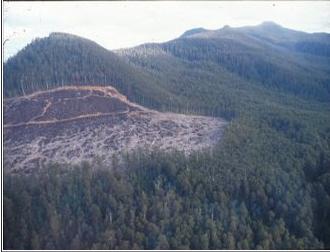 Logging invades Tasmania’s South-West wilderness in the Huon valley,
not far downstream of the above photo.
This logging is ruining the integrity of the adjacent Tasmanian Wilderness World Heritage Area
whose boundaries have been drawn to protect the treeless mountaintops
and leave the forested valleys to the loggers. Logging invades Tasmania’s South-West wilderness in the Huon valley,
not far downstream of the above photo.
This logging is ruining the integrity of the adjacent Tasmanian Wilderness World Heritage Area
whose boundaries have been drawn to protect the treeless mountaintops
and leave the forested valleys to the loggers.
.
Tags: Bill Kelty, Forestry Tasmania, Gillard Labor Government, Independent Verification Group, Julia Gillard, Labor Party, Lara Giggings, old growth forest, recidivist logging, Tasmania, Tasmanian Forests Intergovernmental Agreement, Weld Forest
Posted in + Wild Tasmania, Tasmania (AU), Threats from Deforestation | No Comments »
Add this post to Del.icio.us - Digg
Thursday, December 15th, 2011
“The moment one definitely commits oneself, then providence moves too. All sorts of things occur to help one that would never otherwise occurred. A whole stream of events issues from the decision, raising in one’s favor all manner of unforeseen incidents and meetings and material assistance which no man could have dreamed would have come his way. Whatever you can do or dream you can, begin it. Boldness has genius, power and magic in it. Begin it now.”
~ attributed to Goethe.
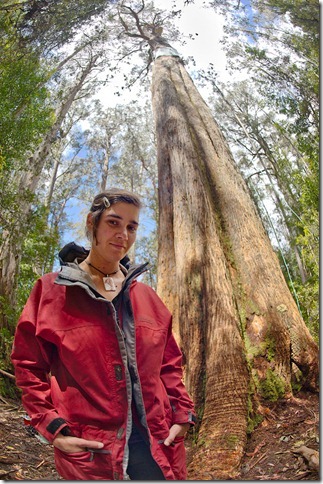 Miranda – Defender of Tasmania’s Forest Heritage
at the foot of ‘The Observer Tree‘
Mount Mueller Forest, Styx Valley, Tasmania
Miranda – Defender of Tasmania’s Forest Heritage
at the foot of ‘The Observer Tree‘
Mount Mueller Forest, Styx Valley, Tasmania
.
One young Tasmanian woman, charged with a deep commitment to her natural island heritage, continues to be prepared to do more to protect Tasmanian old growth forests than most Tasmanians. Miranda Gibson of Still Wild Still Threatened is certainly prepared to do more than the current (read ‘temporary‘) Premier of Tasmania Lara Giddings, and more than the current (read ‘temporary‘) Prime Minister of Australia, Julia Gillard, who have quickly turned their backs on Tasmanians to more populist party-political issues of the day.
.
 Tasmania’s Forest Wars
– what the Intergovernmental Agreement is supposed to resolve. Tasmania’s Forest Wars
– what the Intergovernmental Agreement is supposed to resolve.
.
Gillard and Giddings in breach of Tasmania’s 2011 Forest Agreement
.
Tasmanians are condemning government delinquency on meeting the conservation goals contained in the Gillard Labor Government’s Forests Intergovernmental Agreement (IGA) signed and promised to all Tasmanians in Launceston on 7th August 2011.
 Giddings and Gillard
– hollow Labor promises Giddings and Gillard
– hollow Labor promises
.
IGA Clause 25 states:
.
‘The State will immediately place the 430,000 ha of native forest identified in Attachment A (other than any areas which are not State forest) from the 572,000 ha nominated by ENGOs through the Statement of Principles process, into Informal Reserves.’
.
IGA Clause 27 states:
.
‘In the event that Forestry Tasmania reports that it cannot meet contractual requirements from production resources outside the nominated 430,000 ha the Governments will undertake the following steps. First, an independent expert will be jointly appointed by the Governments to review scheduling and other relevant data and attempt to reschedule harvesting activities so as to meet the requirements of contracts and maintain the interim protection of 430,000 ha. In the event that the independent expert concludes it is impossible to achieve this, the Commonwealth will compensate the contract holder for the value of lost profits and unavoidable costs.’
.
Gillard’s fly-in to Launceston on 7th August 2011 to sign and celebrate the Tasmanian Forests Intergovernmental Agreement with Labor mate Giddings was not a mere plaque unveiling, it was a Tasmanian landmark agreement to provide certainty for Tasmania’s forestry industry, support local jobs and communities, and protect the state’s ancient forests. It deserves the respect of commitment and follow through on promise.
On the one hand it has funded Forestry and its associated families hundreds of millions and with a dignified exit from logging and transition to alternate trades. On the other hand Gillard’s Forest Agreement guarantees protection for Tasmania’s natural but threatened heritage – its most iconic ancient forests, immediately placing 430,000 hectares of iconic old growth native forest into informal reserve – the Styx, Upper Florentine, Huon, Picton and Weld Valleys and the Great Western Tiers, Tarkine and Wielangta.
.
Gillard’s promise made to the Australian people (Prime Minister Gillard’s official website):
.
‘These forests will not be accessed for harvest while verification takes place.‘.
Well, verification is still taking place. And Bill Kelty, who brokered the deal, seems to have run to the hills.
Such a landmark State-wide agreement that promises a ‘strong foundation‘ is hollow if the leadership waddles off to be distracted by other issue so the day, without the committed delegation of trusted lieutenants to see through on implementation. Predecessor PM Kevin Rudd failed classically on the implementation phase of his policy – insulation being his and Garrett’s multi-million dollar incompetent legacy.
“The Australian and Tasmanian governments are taking too long to implement the intergovernmental agreement. If they can get their act together to offer contractors exit packages then they can honour the conservation agreement as well.” Greens Senator Bob Brown has said. “Four months later not one hectare has been protected and Forestry Tasmania continues to fell these magnificent trees as fast as they can put the roads in. All up, more than 10km2 of our wild forests will be destroyed“, Greens Senator Brown said.
All political leaders, while dancing on mountains of power and influence, pragmatically realise that their time in office is temporary. Status quo is not a characteristic of modern democratic politics. What matters most in political careers is legacy. Australia’s current Prime Minister Julia Gillard is starting to stare that legacy in the face as she allows Premier Lara Giddings to breaking the $276 million promise by backing Forestry Tasmania’s current logging of the 430,000 hectares of old growth forest protected under the Gillard Government’s Agreement.
.
Tasmanian Betrayal
.
Gillard and Giddings have allowed Forestry Tasmania to log the protected 430,000 hectares, ignoring the prescribed compensation requirement. Gillard and Giddings have blatantly reneged on their core promise in the Agreement to cease logging and to protect these forests. Gillard and Giddings have betrayed the Tasmanian and Australian people. They have no mandate to stay in power. Their broken promises are to be their legacies.
.
“Those who cannot work with their hearts achieve but a hollow, half-hearted success that breeds bitterness all around”
~ Abdul Kalam, President of India (b.1931)
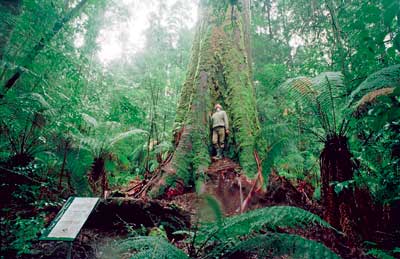 Styx Valley Giants being massacred by State logger ‘Forestry Tasmania’ Styx Valley Giants being massacred by State logger ‘Forestry Tasmania’
.
Tasmania sells itself as ‘the natural state’. But there is a gap between rhetoric and reality as logging of old-growth forests continues – to international dismay.
“And they have these big logs, and you just know they are coming from old-growth forests…I don’t think I could take living there and seeing them every day knowing (the trees) are going mostly to woodchips.” ~ Larraine Herrick or Tumbarumba, Snowy Mountains, New South Wales.
But the Styx has been, and (is continuing) to be, logged by the timber industry in a state in which questions have been repeatedly raised about whether cronyism, corruption and deception underlie the management of forests. Only discovered in 2002, El Grande was a Eucalyptus regnans with a 19-metre circumference. Last autumn (2003), it was killed when a regeneration burn went wrong. Its demise helped fuel a midwinter protest that drew more than 2000 people to the Styx Valley. There, The Wilderness Society and Greenpeace began a tree-sit, 65 metres up a threatened giant eucalypt called Gandalf Staff.
.
[Source: ‘Tasmania: seeing the wood but not the trees‘, by Melissa Fyfe and Andrew Darby, The Age Newspaper, 20040313, ^http://www.theage.com.au/news/science/tasmania-seeing-the-wood-but-not-the-trees/2004/03/13/1078594604573.html]
.
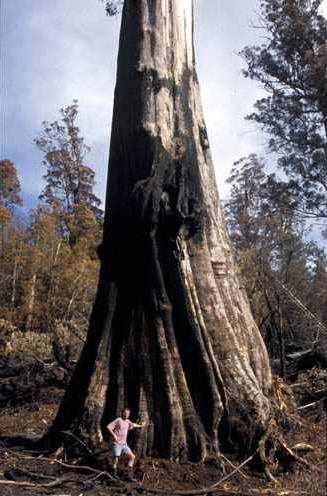 ‘El Grande’
Australia’s largest tree burned to death in 2003 by Forestry Tasmania’s incompetence ‘El Grande’
Australia’s largest tree burned to death in 2003 by Forestry Tasmania’s incompetence
.
Tasmanian forests activist organisation Still Wild Still Threatened have called on the Federal and State governments to honour a $276 million forest deal made on 7th August 2011.
“This deal has already seen $35 million delivered to Forestry Tasmania and Gunns Ltd. without protecting a single tree” said Still Wild Still Threatened spokesperson Ali Alishah.
“It is clear that by backing Forestry Tasmania’s destructive practices within the identified 430,000 ha area of high conservation value native forest, the State and Federal Governments are in direct violation of Clauses 25 and 27 of their own Inter Governmental Agreement.” said Mr. Alishah.
.
.
.
The Observer Tree
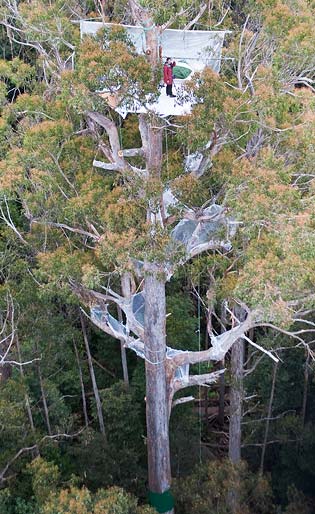
Miranda Gibson on top of The Observer Tree
Totally committed to Tasmanian Forests,
unlike Gillard and Giddings hollow words.
.
Still Wild Still Threatened have this week launched a new tool in the fight to protect Tasmania’s forests today, unveiling the ‘ObserverTree‘, a 17-storey high tree sit and media centre equipped with the technology to record footage of logging operations and stream these images live to the world via the internet.
The Observer Tree is located in the Styx Forest below Mt Mueller, in Tasmania’s western wilderness, part of the 430,000 ha of forest that was supposed to receive immediate protection under the federal-state agreement on forests (the IGA). The Observer Tree is situated at the head of a section of Styx Forest currently targeted for logging by Forestry Tasmania.
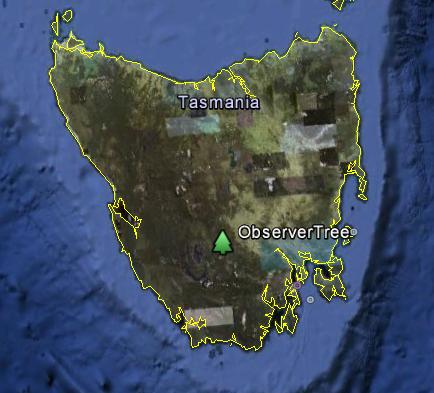 ‘Observer Tree’ location
^http://observertree.org/2011/12/15/observertree-on-google-maps/
‘Observer Tree’ location
^http://observertree.org/2011/12/15/observertree-on-google-maps/
.
Teacher, author and forest activist, Miranda Gibson, has vowed to occupy the tree-platform continuously, until real protection is secured for Tasmania’s forests. Ms Gibson will maintain a daily blog and upload video updates during her stay in the tree, documenting the struggle to protect Tasmania’s forests to concerned people all over the globe.
‘We have used the internet to connect this spectacular patch of threatened Tasmanian forest to the world. The Observer Tree will transmit images and information about the value of the thousands of hectares of forest that remain threatened if Julia Gillard does not keep her word. People across Australia and the globe will have the opportunity to view bear witness to the wasteful destruction of these forests and hear from the people fighting to protect them,’ said Ms Gibson.
For the first time their actual logging will be broadcast live internationally via the web.
Website: ^http://www.observertree.org
Facebook: ^http://www.facebook.com/#!/pages/ObserverTree/152795598158969
Download Google Earth (93MB): GoTo: ^http://www.google.com/earth/download/ge/
.
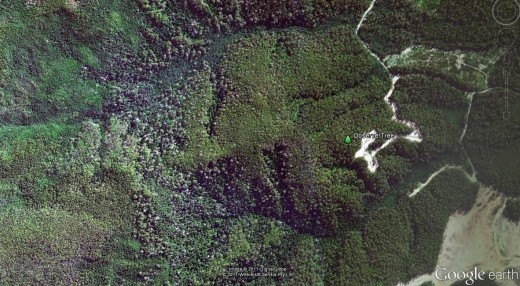 Google Earth’s satellite image of the Observer Tree in dense old-growth, adjacent to Forestry Tasmania’s fresh logging road
(click photo to enlarge) Google Earth’s satellite image of the Observer Tree in dense old-growth, adjacent to Forestry Tasmania’s fresh logging road
(click photo to enlarge)
.
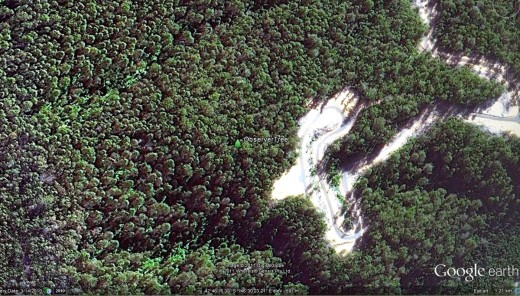 Close up image
(click photo to enlarge) Close up image
(click photo to enlarge)
.
.
Monday: Forestry Tasmania attacks the Styx Forest
.
On Monday 12th December 2011, State forest ‘nazi logger’, Forestry Tasmania, under the command of District Officer (Gauführer) Steve Whitely, rolled in its contracted ‘ecodeath-squad’ into the western end of the magnificent Styx Valley. The targeted forest area is situated at the base of Tasmania’s prominent and wild Mt Mueller on the border of the World Heritage Area. It is situated about 25 km west of the infamous logging town of Maydena.
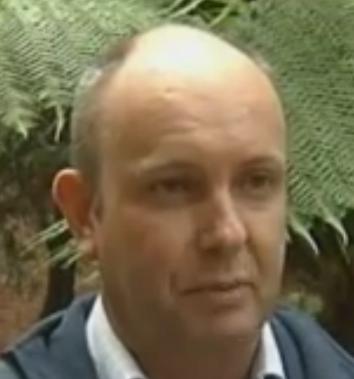 Directing the logging – Forestry Tasmania’s Steve Whiteley
[Source: Southern Cross Television, 20111214]
Directing the logging – Forestry Tasmania’s Steve Whiteley
[Source: Southern Cross Television, 20111214]
.
In true forest nazi style, Forestry Tasmania’s targeted forest area is branded as coupe ‘TN 044B‘.
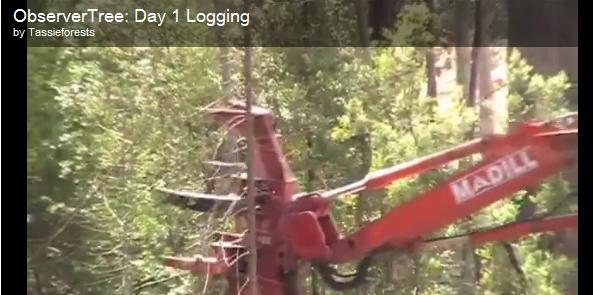 Logging Nazi in and destroying the Styx Valley Forest
Monday 12th December 2011, in direct breach of Prime Minister Gillard’s Forest Agreement. Logging Nazi in and destroying the Styx Valley Forest
Monday 12th December 2011, in direct breach of Prime Minister Gillard’s Forest Agreement.
.
This ‘Madill’ feller buncher was getting well stuck into the Styx Valley last Monday morning just below the Observer Tree. The hydraulic arm clamps onto the trunk of the tree while a cutting mechanism severs the tree at the stump. The machine then lifts the tree, lowers the tree into a horizontal position, and drops the tree on a bunch of logs piled on the ground. The industrial machinery has all the efficiency of a Nazi death factory.
.
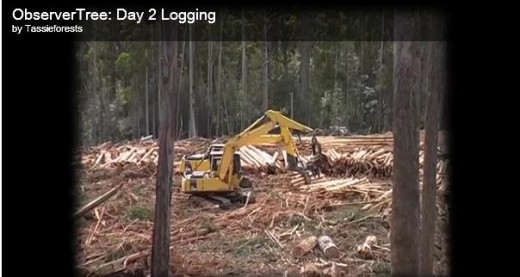
.
Foresty Tasmania is operating in direct contradiction of IGA Clauses 25 and 27. The coupes within the 430,000 ha of high conservation value forest are not to be logged under any condition. The IGA prescribes that relevant customers and contractors are to be granted compensation and million have been set aside for this purpose. Foresty Tasmania under Gauführer Steve Whitely is out of control. He is driving ecological apocalypse in Tasmania’s southern forests. He has become a Walter E. Kurtz.
 Walter E. Kurtz – unhinged, his methods unsound. Walter E. Kurtz – unhinged, his methods unsound.
.
Tags: Abdul Kalam, activist, Bill Kelty, El Grande, Forestry Tasmania, Gandalf, Google Earth, Inter Governmental Agreement, Julia Gillard, Lara Giddings, Maydena, Mount Mueller, nazi logger, Observer Tree, old growth forest, Still Wild Still Threatened, Styx Forest, Styx Valley, Tasmania, Tasmanian Betrayal, Tasmanian Forests Intergovernmental Agreement, The Observer Tree, Woodchipping Tasmania
Posted in Tasmania (AU), Threats from Deforestation, Threats from Weak Environmental Laws, Threats to Wild Tasmania | No Comments »
Add this post to Del.icio.us - Digg
Friday, September 9th, 2011

At a time when the Tasmanian Government has a protracted budget crisis, when Gunns and its logging venture is on the brink of financial collapse, and the Australian Federal Government is offering a $276 million package to the Tasmanian logging industry to transition out of subsidy-dependent logging; this is a time for strategic decision making. This is a time for considering the next generation of Tasmanians.
The days of governments providing subsidies to forestry are numbered. The writing is on the wall for multi-national/industrial hardwood forestry in Tasmania.
Despite the less than perfect negotiations, the undemocratic secrecy of the deal making, State and Federal governments’ poor grasp of change management, Tasmanians are presented with an olive branch. The last time a middle-ground opportunity was available to the two warring sides was the 1989 Salamanca Agreement which was quickly scuttled by government. A generation later, a considerable financial incentive and the facilitation of transition out of logging are on the table.
Irreplaceable old growth forest ecosystems are at stake, but equally at stake are rural livelihoods. There are structural social repercussions that will last decades. But then Tasmania’s poverty is already structural. It has become inter-generational and Tasmanians need a transitional direction out of poverty. While mindful of the recurring history of conflict and community polarisation, this current opportunity for change is rare and perhaps a once in a generation one at that.
In order to begin to appreciate the cultural depth of Tasmania’s ‘age-old conflict‘, at least four particular books should be read on this history:
- ‘The South West Book: A Tasmanian Wilderness‘, compiled by Helen Gee,Janet Fenton and Greg Hodge in 1978, published by William Collins Pty Lts and The Australian Conservation Foundation [Read More]
- Helen Gee’s 2001 book ‘For the Forests: A History of the Tasmanian Forest Campaigns‘, published by The Wilderness Society, Inc. [Read More]
- Greg Buckman’s 2008 book ‘Tasmania’s Wilderness Battles: a history‘, published by Allen & Unwin [Read More]
- Anna Krien’s 2010 book ‘Into the Woods: the battle for Tasmania’s Forests‘, published by Black Ink [Read More]
.
Perhaps as an interested outsider, a mainlander, I can consider this Tasmanian-wide conflict from a detached unencumbered perspective. The younger generations have opportunities that their parents and ancestors never did. Had my grandfather not died on the farm when my father was just eight years old, I may well have followed generations into sheep farming. My grandmother with her only child left the farm to give my father the best opportunity she could. I reflect on that opportunity and the greatly increased opportunity that my parents have provided me and my siblings. It takes one opportunity, for others to become available and sometimes it takes generations.
While not setting out to be critical of sheep farming per se, in hindsight sheep farming in Australia over my lifetime has become low margin and commoditised (like woodchips) and many a wool grower have not experienced the anticipated opportunities flowing on from the halcyon days when Australia was built off the sheep’s back. ‘Once a great nation-building icon, the wool business today is but a third of its size when Australia ‘rode on the sheep’s back’. Compared to the more recent Australian Wheat Board scandal, 40 times more funds were lost in the downfall, and vastly more collateral social and economic damage was done in this country and across the globe.’ Indeed, Charles Massey’s 2011 book ‘Breaking the Sheep’s Back‘ tells the untold story of the events that led to Australia’s biggest industry disaster. [Read More].
Just as Australia’s traditional wool business has declined, so too has Australia’s traditional timber business.
‘Most of the change we think we see in life is due to truths being in and out of favor.’
~ Robert Frost’s 1915 poem, ‘The Black Cottage’.
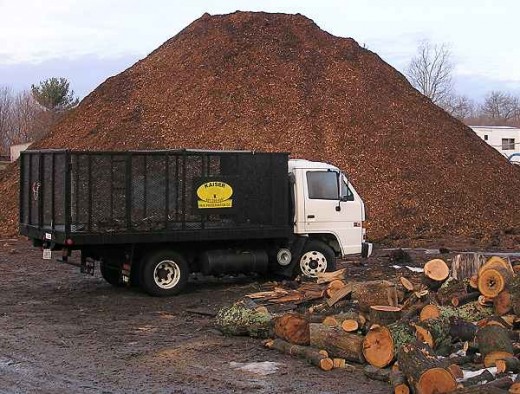 Woodchipping Tasmania only benefits foreign buyers, who must be laughing Woodchipping Tasmania only benefits foreign buyers, who must be laughing
.
Once island problems are recognised for what they are (internal island problems), the quicker more Tasmanian’s will recognise that the future challenges and opportunities of the island lie with industry diversification, value adding produce and services and with the world outside it. Trading internationally directly is where Tasmania’s future prosperity lies. Tasmania can learn much from the pure brand of ‘New Zealand’. Much of Tasmania’s output competes in comparable industries with the output of New Zealand.
Past and current generations of Tasmanians have become familar with old growth forests and many have become complacent of their presence. Future generations have a right to that familiarity.
Tasmanian complacency was the root cultural cause behind the eventual extinction of the Thylacene.
 Extinction is forever ~ the dark past should not curse our future Extinction is forever ~ the dark past should not curse our future
.
“Tasmania is slowly evolving towards goals we cannot now see. If we can revise our attitudes towards the land under our feet; if we can accept a role of steward and depart from the role of conqueror; if we accept the view that man and nature are inseparable parts of a unified whole – then Tasmania can be a shining beacon in a dull, uniform and largely artificial world”.
~ Olegas Truchanas, 1969
[Source: ^http://florentine.org.au/]
.
.
Intergovernmental Forests Agreement, 2011
.
In October 2010, the major breakthrough in the almost century long dispute over Tasmania’s forests was reported secured in principle between the key parties, Tasmanian timber communities, forest unions, and industry, Gunns, Environment Tasmania, the Conservation Council, The Wilderness Society, Australian Conservation Foundation. Credit is due to the two instrumental negotiators, Gunns chief executive Greg L’Estrange and forest facilitator Bill Kelty.
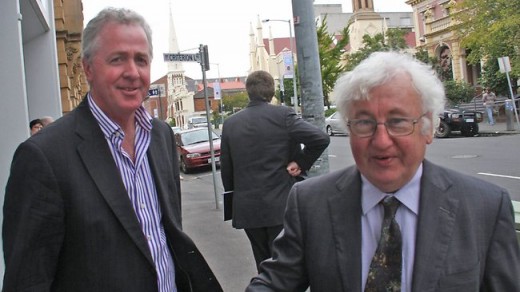 Tasmanian History in the making Tasmanian History in the making
.
The aim was to find an agreement develop a more sustainable timber industry and to end logging Tasmania’s remaining valuable native forests. It will mean an end to logging of native forests will also protect critical habitats for Tasmanian devils and other threatened species. A moratorium on the logging of high native forests will be phased in over three months, while maintaining essential supplies for necessary timber mill operations.
The “Tasmanian Forests Statement of Principles” were agreed to set Tasmania’s timber industry on a new path to economic opportunities through plantation-based forestry, protecting timber worker’s jobs and native forests.
.
.
“The forestry industry, unions and environment groups have found common ground in the interests of all Tasmanians. This will pave the way for a sustainable timber industry that protects jobs and also protects the state’s remaining unique native forests,” said Environment Tasmania’s Phill Pullinger..
.
[Source: ‘Forests: Peace in our time?’, by Andrew Darby, The Age, newspaper, 20101019, ^http://tasmaniantimes.com/index.php/article/peace-in-our-time]
.
.
.
Tasmanian Transition from High Volume/Low to Low Volume/ High Value Add Timber – public debate recommended
.
While not advocating industrial logging of Tasmania’s native myrtle, a refocus from high volume/low margin woodchips toward low volume / high value specialised timbercraft is a Tasmanian industry that has potential to be both commercially viable while being ecologically sustainable, if excluding old growth and so long as it is appropriately tightly controlled and monitored.
A public debate on this potential is recommended.
 High value-add Electric Guitar in Tasmanian Myrtle
[Source: ^http://tasmaniantonewoods.com/guitars] High value-add Electric Guitar in Tasmanian Myrtle
[Source: ^http://tasmaniantonewoods.com/guitars]
.
.
Further Reading:
.
‘Gunns rejects crucial financial offer’
.
[by Andrew Darby, The Age newspaper, 20110906, ^http://www.theage.com.au/national/gunns-rejects-crucial-financial-offer-20110905-1ju9j.html]
.
‘Troubled forestry company Gunns has rejected a financial offer from the Tasmanian government seen as key to the future of the state’s timber industry. The settlement for exiting native forest logging was critical both to Gunns’s future operations and to a landmark forests peace settlement.
”The state government has been formally advised by Gunns Limited of their decision to reject our offer of commercial settlement,” a spokesman for Premier Lara Giddings said yesterday.
The settlement was needed to unlock funding for contractors squeezed by the exit from native forests in a $276 million federal-state package. Rejection comes with Gunns into the fifth week of a stock exchange trading halt, called for the settlement negotiations, with its share price at an all-time low of 20.5¢. The settlement, covering tens of millions of dollars, was meant to extinguish Gunns’s legal rights over native forest contracts with Forestry Tasmania.
.
.
.
‘Tasmanian Forests Agreement (official announcement)’
.
[Source: The Australian Government, 2011, ^http://australia.gov.au/content/tasmanian-forests-agreement]
.
‘The Prime Minister and the Tasmanian Premier have announced a $276 million funding package to support the adjustment of the Tasmanian forestry industry, and to create a significant conservation benefit by reserving and protecting High Conservation Value native forest areas. The Tasmanian Forests Intergovernmental Agreement is designed to support the forest industry to progressively transition to a more sustainable and diversified footing and to build regional economic diversity and community resilience.
The agreement includes:
.
Support for workers, contractors and communities
- Up to $25 million to provide immediate employment and training support for redundant forest workers
- Intensive support through Job Services Australia and other providers relocation support for redundant forestry workers
- $15 million for transition support payments (through ForestWorks)
- $1 million over two years for mental health counselling and community well-being services (through Rural Alive and Well)
- $45 million for voluntary exits from public native forest operations for haulage, harvest and silvicultural contractors.
Tasmanian forest industry workers can call the Tasmanian Forest Support Information Line on 1800 648 075 for more information about the services and payments that may be available to them.
Protecting high conservation value forests and ensuring sustainable wood supply
- Guaranteed annual sustainable timber supply of at least 155,000 cubic metres of high quality sawlog per year and 265,000 cubic metres of peeler billets each year
- Provision for speciality timber, noting that the industry claim is 12,500 cubic metres per year, subject to verification funding to support an independent verification process
- Funding for a voluntary sawlog contract buy-back program for sawmillers wishing to exit the industry
- 430,000 hectares of native forest immediately placed into Informal Reserves
- Legislation no later than 30 June 2012 to formally protect the areas of reserve determined by the independent verification
- $43 million to implement this Agreement (including at least $5 million to support provision of information and consultation with affected communities)
- $7 million per year to support management of additional reserves.
Economic diversification
- $120 million over 15 years to fund regional development projects
- Development of a process to identify by mid 2012:
- the impacts of forestry adjustment on affected regions, including the scope for
- alternative sectors and jobs to support regional adjustment
- progress in implementing Commonwealth and Tasmanian adjustment measures
- the need for further regional development assistance
- A major research and analytical project to underpin this process.
.
.
‘Giddings acts to avert budget crisis’
[Source: Brand Tasmania Newsletter, March, 2011, Issue 114, ^http://www.brandtasmania.com/newsletter.php?ACT=story&issue=114&story=1]
 Tasmanian Premier and Treasurer, Lara Giddings
Photo courtesy of The Hobart Mercury
Tasmanian Premier and Treasurer, Lara Giddings
Photo courtesy of The Hobart Mercury
.
As unemployment figures for January showed a monthly rise from 5.0 to 5.6 %, the Premier and Treasurer, Lara Giddings, foreshadowed a 3 % cut in public sector spending and warned Tasmanians to expect three tough Budgets as the State’s balance sheet is shifted back into the black.
Releasing the Mid Year Financial Report on 10 February, Ms Giddings said several 2010 elections promises would have to be scrapped in the drive to off-set an $800 million loss of revenue. She outlined the following immediate savings:
- $97.5m cancellation of equity transfers to GBEs;
- $30.9m scrapping of planned Helicopter Emergency Medical Service;
- $18.0m shelving of proposed Cosgrove Specialist Sports School;
- $ 3.8m dropping of the Events Attraction Program;
- $ 2.0m closing down the Renewable Energy Loan Fund
- $ 3.9m deferring IT projects over two years; and
- $ 2.5m cutting ministerial and parliamentary office expenditure.
“These savings will improve the Government’s financial position in the short term while longer-term structural changes are being developed and implemented,” Ms Giddings said.
She told a media conference the savings needed were the equivalent of 2,300 jobs and she could not rule out forced redundancies in the public service, nor cuts to frontline services. Unions immediately branded her as the first Labor Premier in history to announce public service sackings.
.
“I want to be open and frank with people about the problems we are facing,” Ms Giddings said.
“We are in a place where we need to see significant action to avert a crisis. This is not a crisis; this is an unsustainable situation that will lead to a crisis if action isn’t taken now.”
.
[Editor’s note:
To the contrary, a ‘crisis‘ in a governmental context is defined by the Merriam-Webster dictionary as:
“an unstable or crucial time or state of affairs in which a decisive change is impending; especially : one with the distinct possibility of a highly undesirable outcome <a financial crisis>“]
.
The number of people on the State Government payroll has increased 24 per cent this decade to 25,000 – almost one in every nine employed Tasmanians. Economic commentator Saul Eslake has pointed out that it costs public employees 14 per cent more a year to deliver services to each citizen, compared with their counterparts in Victoria.
So the Government expects job cuts, spending cutbacks and increased efficiency in the public service to contribute $270 million of the $420 million it hopes to save over the next four years.
Ms Giddings said it was regrettable that some worthwhile Government programs could not be continued, but strong action was needed in response to falls in GST revenue and other income in the wake of the global financial crisis. “I am determined to take the steps necessary to protect the Government’s financial position,” Ms Giddings said. “While I would prefer not to have to take some of these measures, I believe they are essential if we are to avoid sliding back into net debt.”
A Sensis Business Index released in late February reinforced the need for decisive action, Ms Giddings said. “The national downturn in retail trade is a concern the State Government shares with local retailers, as it continues to directly impact upon the State budget through reduced GST receipts.”
.
[ Read More]
.

– end of article –
.
Tags: Bill Kelty, Forest Reserve Map, high conservation value forests, Intergovernmental Forest Agreement, Tasmanian Budget Crisis, Tasmanian complacency, Tasmanian Forests Statement of Principles, Tasmanian logging, Woodchipping Tasmania
Posted in Tasmania (AU), Threats from Deforestation, Threats to Wild Tasmania | No Comments »
Add this post to Del.icio.us - Digg
|
|
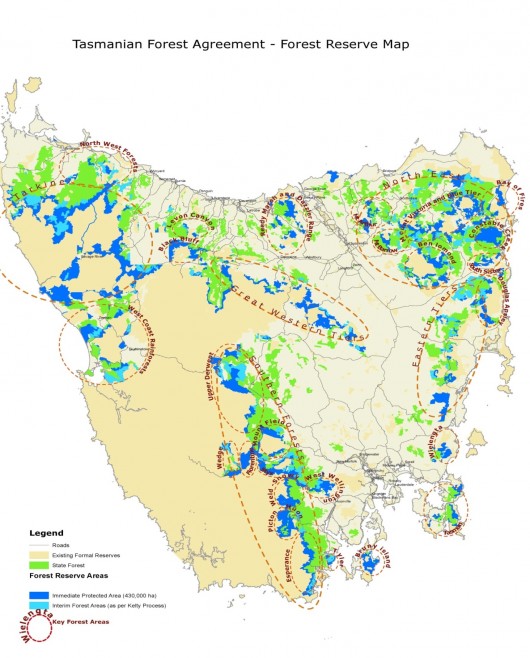 Forest Reserve Map – ‘Interim Reserve Boundaries’ (IGA)
Forest Reserve Map – ‘Interim Reserve Boundaries’ (IGA) 























